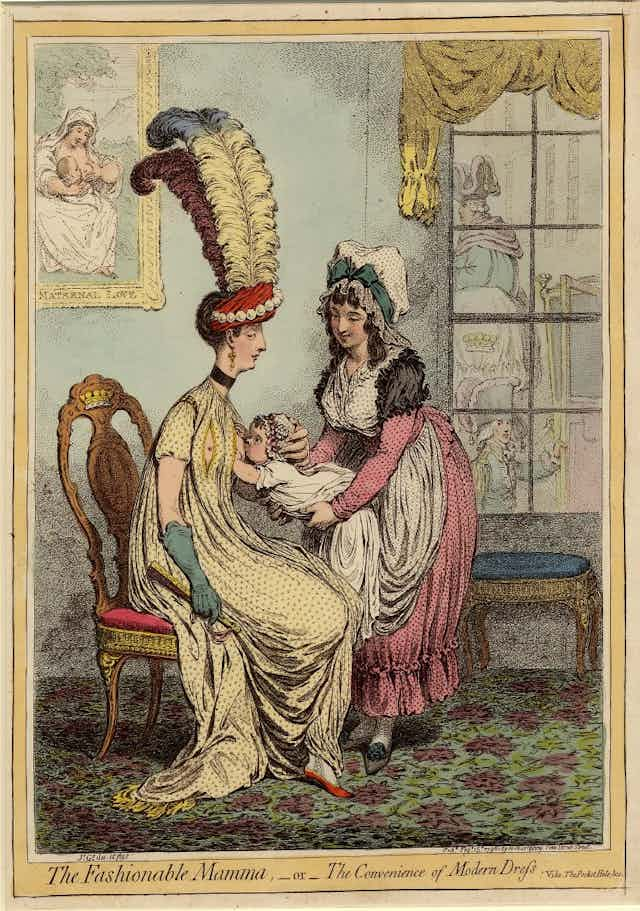It’s a predictable tale of controversy in modern public space: a woman or group of women are welcomed to or excluded from a place because they are breastfeeding. The event makes the midday news and ushers in debate about whether breastfeeding is a fact of life or something that should be cloaked away in private.
Last week, a Sydney cafe owner’s sign welcoming breastfeeding mums in for a free cuppa made its way to headlines and internet viral status. As usual when this issue arises in the news, the story was greeted with passionate responses praising the gesture and a few intentionally inflammatory comments about inappropriateness, decency and the “special” treatment of women.

These periodically recurring controversies, from Jamie Oliver’s opinions on breast milk to the North Carolina woman kicked out of a courtroom on Monday for breastfeeding her son, highlight that breastfeeding and public space are still uncomfortable bedfellows in the 21st century.
Discussions about the “nurturing versus the sexual” aspects of the breast are often framed as a uniquely modern problem, an ongoing struggle with social norms in the wake of women’s liberation. Assumptions about past social behaviours are rife, picturing either a wholly modest and private world of infant suckling or ideal, liberated breastfeeders free from the sexualised advertising that dominates contemporary society.
As usual, the truth is considerably more complicated, and looking at this from the historian’s viewpoint raises some surprising insights.
Breastfeeding in the 18th and 19th centuries
Take the example of the cafe, a feature of modern life that has its roots in the 18th century coffee houses, themselves vital arenas for the development of public space.
Historians disagree about the extent to which women were actively excluded from coffee houses, but whether they were completely absent or only rarely involved, there’s no doubt that “respectable” women weren’t as involved in this type of public space as they are today.

Despite the ostracism of women from these public arenas, the evidence of images, paintings and prints that depict breastfeeding suggest it wasn’t a sight completely absent from public life.
I’ve encountered many dresses, bodices (tops of garments) and corsets made for or altered to accommodate breastfeeding. These garments, often hidden away in museum collections, show that women have navigated issues of visibility, fashion and breastfeeding for generations.

Let’s go inside a 19th century wardrobe: many dresses from this time have a hidden secret in their bodices; secrets that reveal a need or desire to breastfeed while wearing fashionable clothing suitable for public appearance. Some have slits cut into the fabric across the breast, often somewhat shoddily inserted and sewn by hand.
These outfits aren’t informal gowns intended for wearing indoors, and include everything from silk gowns to printed cotton bodices. The slits allowed the woman wearing the outfit to feed through them, often hiding them beneath fashionable features such as the trim on Mary Halpin’s 1860s gown, see below.

Nineteenth century nursing slits don’t completely expose the breast and often have ties, buttons, or even uncomfortable looking hooks and eyes, to keep the breast hidden when not in use, and not completely exposed while feeding.
The visibility of breasts while nursing an infant was evidently a key concern to the women wearing these garments. A long way from the discreet blankets modern women often feel pressured to cover up with to be sure, but the pressure of judgement and being viewed by others is a common thread.
Fashion, morality and breastfeeding come together in clothing, but also more generally in trends in infant feeding in the late 18th and 19th centuries. Wet-nursing, the common practice of hiring a recent mother to breastfeed the child of a family usually of a higher social status, meant that breastfeeding was a job, and source of income for many women, and a source of pride.
Royal and aristocratic women often hired women for their moral qualities as much as the quality of their breast milk. So respectability and breastfeeding were linked for those women, their feeding simultaneously a personal private act and a public appointment. At other times breastfeeding itself was fashionable, such as in late 18th century Britain.

The influential and inimitable Georgiana, Duchess of Devonshire, breastfed her legitimate children, something that helped fuel the trend but also exposed her to mockery and judgement of her skills as a mother on the basis of her nursing activity.
Caricaturist James Gillray’s famous The Fashionable Mamma (or, the Convenience of Modern Dress) also uses breastfeeding, clothing and exposed breasts to satirise the behaviour of women: once again, a familiar story to a modern audience.
Our response to public breastfeeding is continually evolving. Decency, appearance and practicality remain issues that affect how we talk about nursing mothers.
The pressure of medical advice and social norms is just as powerful now as it was for breastfeeding women of the 18th and 19th century. So too is the desire to combine ideas of fashion and respectability with the need to feed an infant.
Examples of how women achieved this through their clothing in the past highlight that the contemporary debate about visible breastfeeding is not entirely a contemporary problem.
Catriona will be on hand for an Author Q&A from 4 to 5pm AEST on Tuesday 19, 2016. Post any questions you have in the comments below.

